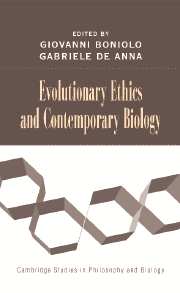Book contents
- Frontmatter
- Contents
- List of Contributors
- Evolutionary Ethics and Contemporary Biology
- Introduction
- PART I THE LIMITS OF EVOLUTIONARY EXPLANATIONS AND JUSTIFICATIONS OF ETHICS
- PART II METHODOLOGICAL ISSUES CONCERNING EVOLUTIONARY ACCOUNTS OF ETHICS
- PART III HOW BIOLOGICAL RESULTS CAN HELP EXPLAIN MORALLY RELEVANT HUMAN CAPACITIES
- 5 Genetic Influences on Moral Capacity: What Genetic Mutants Can Teach Us
- 6 Evolutionary Psychopharmacology, Mental Disorders, and Ethical Behavior
- 7 The Biology of Human Culture and Ethics: An Evolutionary Perspective
- PART IV HOW BIOLOGICAL RESULTS CAN HELP EXPLAIN MORAL SYSTEMS
- Index
- Cambridge Cultural Social Studies
- References
5 - Genetic Influences on Moral Capacity: What Genetic Mutants Can Teach Us
Published online by Cambridge University Press: 23 July 2009
- Frontmatter
- Contents
- List of Contributors
- Evolutionary Ethics and Contemporary Biology
- Introduction
- PART I THE LIMITS OF EVOLUTIONARY EXPLANATIONS AND JUSTIFICATIONS OF ETHICS
- PART II METHODOLOGICAL ISSUES CONCERNING EVOLUTIONARY ACCOUNTS OF ETHICS
- PART III HOW BIOLOGICAL RESULTS CAN HELP EXPLAIN MORALLY RELEVANT HUMAN CAPACITIES
- 5 Genetic Influences on Moral Capacity: What Genetic Mutants Can Teach Us
- 6 Evolutionary Psychopharmacology, Mental Disorders, and Ethical Behavior
- 7 The Biology of Human Culture and Ethics: An Evolutionary Perspective
- PART IV HOW BIOLOGICAL RESULTS CAN HELP EXPLAIN MORAL SYSTEMS
- Index
- Cambridge Cultural Social Studies
- References
Summary
Lo maggior don che Dio per la sua larghezza
fesse creando, ed a la sua bontate
più conformato, e quel ch'è più apprezza,
fu de la volontà la libertate;
di che le creature intelligenti,
e tutte e sole, furono e sono dotate.
Dante Alighieri, Paradiso, V, 19–24Discussions about the relations between genes and free will, in particular in relation to morality, are nothing but a new chapter of an old story, the beginning of which can be traced back before the birth of Western philosophy. Is man really free in choosing moral values and moral actions? Are there biological, physical, metaphysical, or divine constraints?
We know that throughout the history of philosophy, the debates on moral freedom have reached an extremely high degree of sophistication. Certainly this is not the place to deal with this vast topic. More modestly we will limit ourselves to consider some data coming from genetics, in order to understand, from a biological point of view, to what extent we can say we have free moral will, and how far our freedom can reach.
A long-standing tradition, well expressed in Dante Alighieri's verses, holds the view that free will is a specific characteristic of humans. But some scholars thought that all human choices are determined. In particular there were those supporting the idea that man's choices are determined by his genome: we would be our genes.
- Type
- Chapter
- Information
- Evolutionary Ethics and Contemporary Biology , pp. 77 - 96Publisher: Cambridge University PressPrint publication year: 2006
References
- 1
- Cited by



